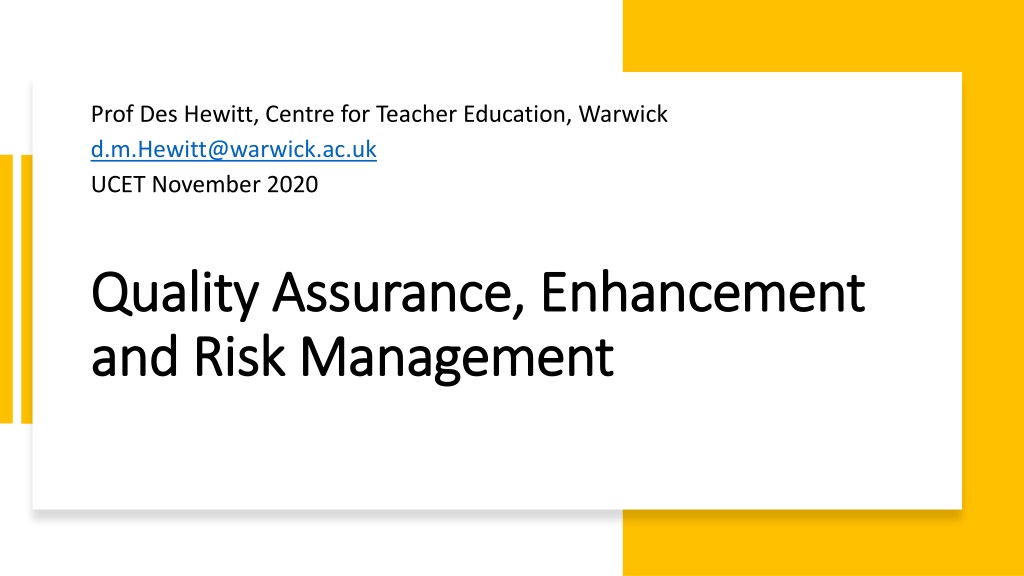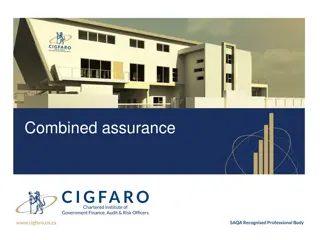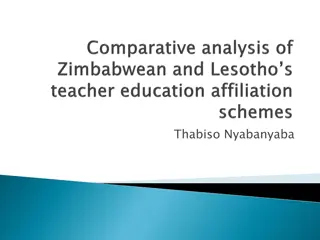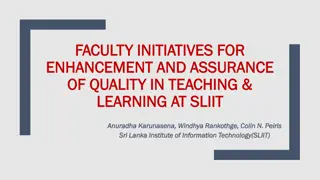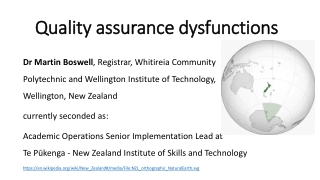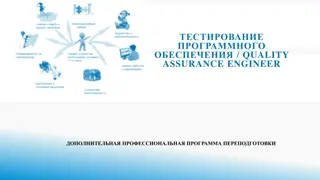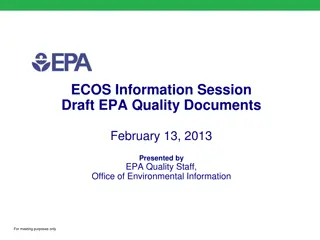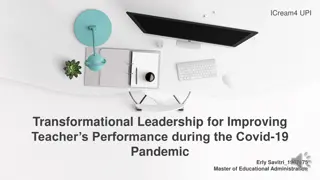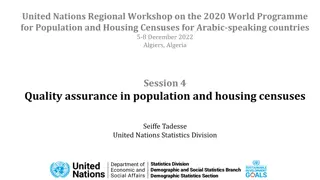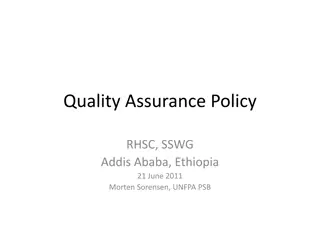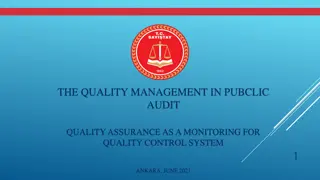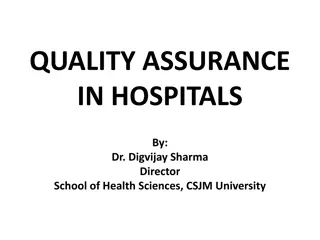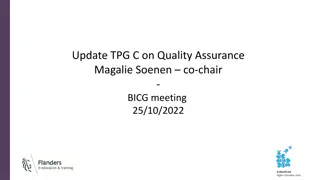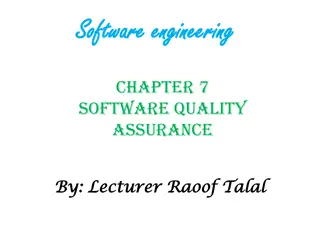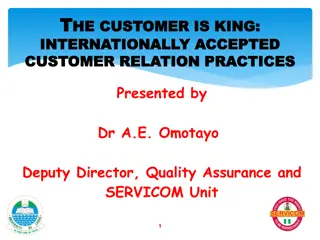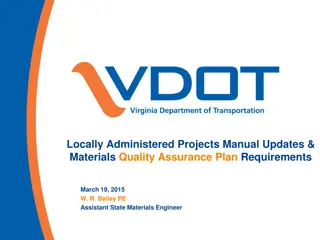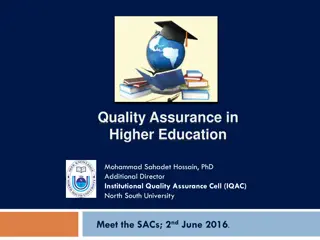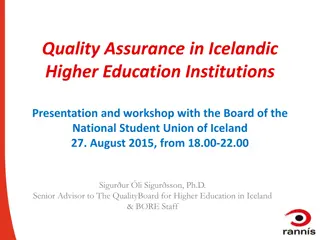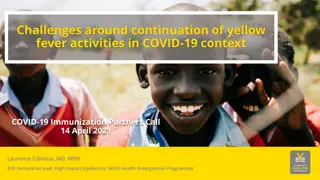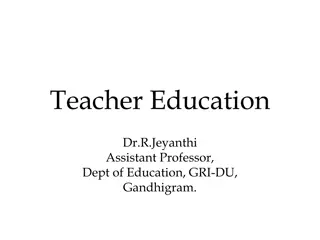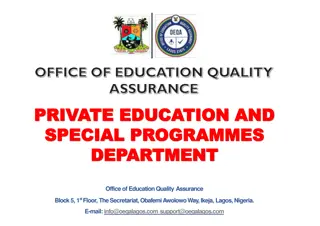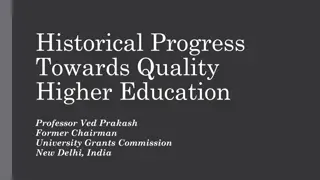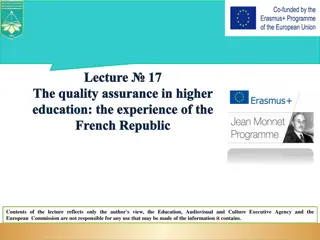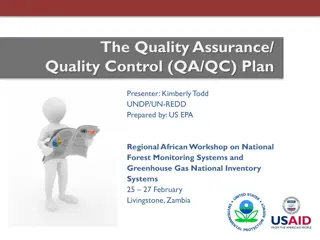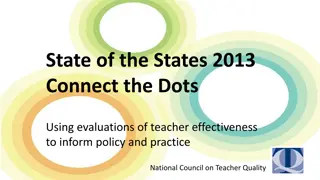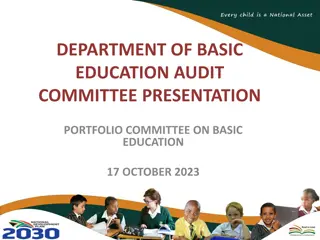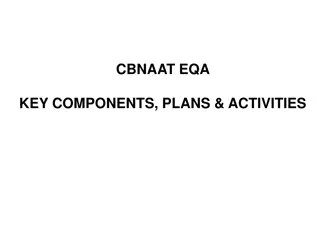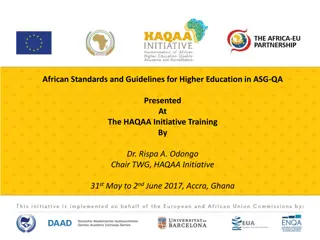Quality Assurance and Risk Management in Teacher Education Amidst Covid-19
Despite challenges posed by Covid-19, this article discusses the key questions, evaluation methods, and changes in Quality Assurance processes within teacher education. Emphasizing a Quality First approach, it outlines strategies for building capacity, adapting to Covid-19 circumstances, and balancing risks effectively. The article sheds light on adapting training methods, online communication, and workload management for students, mentors, and teachers.
Download Presentation

Please find below an Image/Link to download the presentation.
The content on the website is provided AS IS for your information and personal use only. It may not be sold, licensed, or shared on other websites without obtaining consent from the author. Download presentation by click this link. If you encounter any issues during the download, it is possible that the publisher has removed the file from their server.
E N D
Presentation Transcript
Prof Des Hewitt, Centre for Teacher Education, Warwick d.m.Hewitt@warwick.ac.uk UCET November 2020 Quality Assurance, Enhancement Quality Assurance, Enhancement and Risk Management and Risk Management
Despite the context, mode of delivery and local conditions, the key questions are: Principles of QA/ E and Risk Management Is the quality of the academic and professional outcomes (and provision) at least as good as other providers? Are we delivering our programmes (LOs with assessment opportunities)? Are we meeting statutory requirements (H&S, Equality, ITT Criteria, OFSTED [CCF] etc) How do we know that? Evaluation of student and school data/ information Evaluations by students, schools, tutors (all online); Internal moderation by mentors (face to face) External moderation by Examiners (online)
A Quality First approach to teacher education; Building capacity: in SLT, oversight (committees), partnership; for instance, through training; 360 degree (regular) communication strategy (students, staff, partners, University); A measured but decisive response to national and local Covid-19 circumstances; Balancing risks: understanding the cost/ benefits of activities/ actions So how has QA changes as a result of Covid-19? Don t over complicate Promoting quality, addressing risk
Up to 4 hours per student Online meeting with mentor and/ or class teacher All online communication up to Xmas (by University Link tutors) General progress School-based training (Observation by trainee, any CPD in school etc) We ll make a decision in November about a return to face to face/ school visits Online Online School School- -based Moderation Moderation in Autumn in Autumn term term Workload and trainee s response (is it manageable and in line with expectation); Personal tutor/ Moderating Link Tutor based Some ideas for using this time: Discuss the above lesson the student has taught and the mentor s evaluation/ observation; Online meeting with student Student to explain/ discuss: Targets/ actions: identified in above to be discussed with mentor and trainee, preferably together, but that may depend on availability the context (physical environment, range of needs, the broad and balanced curriculum); A lesson they have taught which has been observed and evaluated by the mentor; Purpose Share copies of mentor evaluations. Moderation of quality of training and impact on trainee Formative: Refocus on training and away from outcomes Summative: Refocus on outcomes and the quality of the training/ curriculum experience
Focus for OFSTED ITE Inspection Focus for OFSTED ITE Inspection Are trainees receiving their minimum entitlement to the Core Content Framework? COVID-19 (coronavirus) As schools and educational settings return to a new form of reality, those in ITE will be looking to provide an ambitious curriculum that can be flexibly adapted to meet the ever-changing landscape. We introduced a transition statement in the good criteria of our handbook, for the education and training judgement, so that partnerships who can demonstrate that they have an ambitious and compliant curriculum, will not be unfairly penalised if they are not able to deliver it in its entirety.
Do we provide our students/ trainees with the knowledge they need? Procedural Knowledge: ITT Core Content Knowing how . to plan, teach and assess Centre, Centre, Alliance and Alliance and School School- -based provision/ ITT provision/ ITT Core Content Core Content Declarative knowledge: ITT Core Content Knowing that (content / knowledge per se) based Critical knowledge: HE Level 4-7 assessment criteria Knowing why (principles and theory underpinning professional approaches) Knowing why (ethical stance of teacher)
OFSTED ITT Inspection Grade 2 criteria (extracts) OFSTED ITT Inspection Grade 2 criteria (extracts) Intent: principles informing the ITE curriculum Intent: principles informing the ITE curriculum Ambitious In primary and secondary programmes, the ITT core content framework defines in detail the minimum entitlement of all trainee teachers, which all ITT partnerships must incorporate in full within their curriculums. The ITE curriculum covers the full entitlement described in the ITT core content framework, including all learn that and learn how to statements. Designed around subject and phase The course structure is designed around subject- and/or phase-specific dimensions. The application of any generic principles is taught and practised as and when appropriate. Purposefully integrated The ITE curriculum is purposefully integrated across its different partnership settings. Inclusion and teaching pupils with SEND are meaningfully integrated into all aspects of the training programme. Informed by up-to-date or pertinent research The ITE curriculum is designed to ensure that trainees engage with up-to- date or pertinent research findings, for example the research informing the ITT core content framework (for primary and secondary phase trainees). Trainees know about up-to-date research for promoting inclusion and teaching pupils with SEND, and those who speak EAL. They are able to apply this knowledge in their subject and phase.
Self evaluation / Pre Self evaluation / Pre- -inspection phone calls with inspectors inspection phone calls with inspectors 1. the partnership s context, and the progress it has made since the previous inspection, including assessment of the partnership s current strengths and weaknesses, and any specific progress made on areas for improvement identified at previous inspections that remain relevant under the current inspection framework 2. how leaders ensure, and assure themselves of, the ambition of the ITE curriculum, that it is designed around subject and phase dimensions, and that it is coherently planned and sequenced towards cumulatively sufficient knowledge and skills for future learning and employment 3. for partnerships that include primary and secondary trainees, the way in which leaders have translated the ITT core content framework into a carefully sequenced curriculum for trainees and how they have ensured that all aspects of that framework are covered. Inspectors will also discuss aspects of the programme that go beyond that framework. The discussion will explore how and why leaders have prioritised particular aspects of the programme 4. how the partnership assesses trainees formatively throughout the course (and summatively against the teachers standards for primary and secondary trainees, including those on the assessment only route and the early years teachers standards for early years trainees) 5. how trainees are taught to promote pupils positive behaviour and attitudes, and how their practice in meeting the needs of pupils who speak English as an additional language (EAL) and pupils with special educational needs and/or disabilities (SEND) is developed throughout the ITE curriculums offered 6. how leaders have ensured that the partnership is contributing to and meeting the local demand for teachers 7. any enhancements and adaptations to the programme to meet the needs of current trainees and local/national priorities 8. how leaders ensure (where applicable) that the centre-based and placement-based ITE curriculums are integrated to ensure that trainees make the best possible progress in their teaching 9. how leaders ensure, and assure themselves, that trainees receive clear, consistent and effective training and mentoring 10. how leaders ensure formative and summative assessment of trainees progress in mastering the components of the ITE curriculum, without creating an unnecessary burden.
11. How does the university ensure the quality of ITE provision across the partnership with schools? Additional Questions Impact of COVID 1. Evaluation of the ITT changes to any of the above and their impact arising linked to Covid-19 2. Evaluation of additional measures to ensure quality, consistency and parity of training during COVID-19
Next steps Update on OFSTED/ Core Content Framework Priorities o What can we achieve in the time we have? o What do we have to do between now and January? o How can we use existing structures (meetings etc)? o How can we effectively communicate details with staff, students and schools given the current situation? o What is the impact of continuing issues with Covid-19 into Spring?
